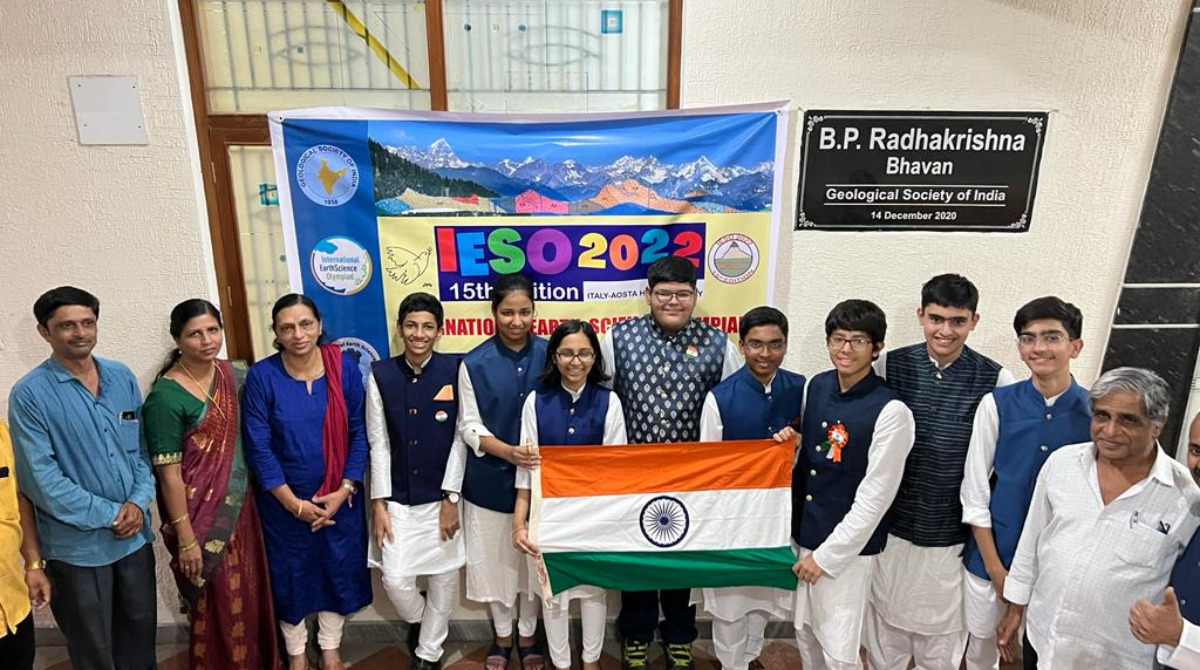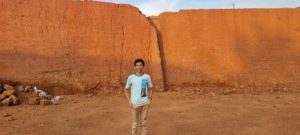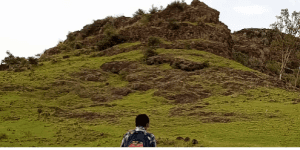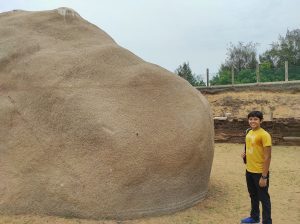South First speaks to three of the young gold medallists. We also take a look at how to participate in IESO, and the selection procedure.

The Indian team that took part in IESO 2022. (Third from Left to Right) Prof. Hema Achyuthan (one of the mentors), Bhanav Namboodri, Avishi Agrawal, Siddangana Sahoo, Jaagrit Gaur, Sonit Sisolekar, Kyishong Bharali Das, Abhijay Singh Khehra, Arush Chaudhary, and N Rajendran, Director (Retd.), Geological Survey of India
India won 14 medals — four gold, four silver, and six bronze — at the International Earth Science Olympiad 2022, held virtually this year from 25–31 August.
The Olympiad was organised from Aosta Valley in Italy and 38 countries participated in it. The eight Class 9–11 students who represented the country were based in the Geological Society of India, Bengaluru, during the event.
Hema Achyuthan, a professor in the Department of Geology, Anna University, was one of the team’s mentors.
She has been associated with the Indian teams that have participated in the International Earth Science Olympiad (IESO) since 2013, and this was her seventh Olympiad.
“We did very well this time, both in team and individual events,” she told South First.
She added this would be India’s second-best performance in the IESO. “In 2019, with four students, we won 13 medals,” she noted.
Bhanav Namboodri, a Class 9 student from Malappuram, Kerala, won four medals in the International Earth Science Olympiad 2022 — a gold, two silvers and a bronze.

Bhanav Namboodri, who won four medals in the International Earth Science Olympiad, at Angadipuram in Kerala to collect laterite (Supplied)
“Hands down, this is one of the most memorable experiences in my life. To win medals for India, my country, it is a proud moment for me,” Bhanav told South First.
“South India is very diverse in geology. My dream is to analyse rocks in South India,” he said.
Bhanav, Kyishong Bharali Das (Chennai), Avishi Agrawal, and Sonit Sisolekar (Pune) were the four members of the Indian team that won a gold medal for the National Team Field Investigation project titled ‘Carbon sequestration in weathered rocks and its application in reducing global warming’.
“The topic was decided by Sonit, and Raymond Duraiswami [from the Department of Geology, Savitribai Phule Pune University] guided him in a great way. Once the framework of the project was done, all of us chipped in and sculpted the presentation well,” Prof Achyuthan said.
Sonit, who won one gold medal and two bronzes in the International Earth Science Olympiad 2022, has been studying lava flows in the Deccan Traps since 2019.

Sonit Sisolekar, who won three medals in the IESO, on his way to collect basalt samples from the Deccan Traps (Supplied)
A Class 10 student from Pune, Sonit has been called India’s youngest volcanologist, as his friend and teammate Kyishong pointed out.
“Near my home, I discovered two new lava tubes in 2019. They are caves formed due to the flow of lava. So I had been in touch with Raymond Duraiswami and since then, I have been working on the topic,” Sonit, who received the Pradhan Mantri Rashtriya Bal Puraskar in 2021, told South First.
“For the IESO, we had decided to work on an environmental issue. That’s why we connected the basalt of the Deccan Traps with the carbon sequestration challenge, since basalt is known to be very effective,” Sonit added.
The four team members, with the help of their mentors (and family too in some cases), collected ancient rocks from different parts of India for analysis.
Kyishong, a Class 10 student from Chennai who won a gold and a bronze in the IESO, collected charnockite from Muttukadu, on the outskirts of the Tamil Nadu capital, with the help of Prof Achyuthan.
“The charnockite I collected from Muttukadu is around 2.6 billion years old. Sonit visited Daundaj to get basalt and red bole samples from the Deccan Traps there, around 65 million years old. Bhanav went to Angadipuram to collect laterite. Avishi went to Mishroli in Jhalawar district (Rajasthan) to collect basalt samples from the northern Deccan Traps,” Kyishong told South First.
They all gave a portion of the samples to Sonit for XRF (X-ray fluorescence) analysis. Sonit performed the analysis at the Indian Institute of Science Education and Research (IISER), Pune, with the help of Gyana Ranjan Tripathy, associate professor and chair, Earth and Climate Science, at the institute.
“We analysed the data and compared the percentages of various oxides in the different rocks. We found that the flow f1, the lowermost lava flow, of the Daundaj sample [obtained by Sonit], was the best for capturing and storing carbon,” Kyishong explained.
Kyishong presented the project in front of the evaluation panel. The jury members were looking for science in these research projects, Prof Achyuthan said.
“They checked whether the students understood the proper science behind the project, the reasoning. What did they understand about the problem that they chose, where are the gaps, what kind of methodology they used — these were the things they were looking for,” she said.
The other four Indian students — Abhijay Singh Khehra (Jalandhar), Jaagrit Gaur (Chandigarh), Siddhangana Sahoo (Bhubaneswar), and Arush Chaudhary (Kota) — too won a gold for their team project.
Since they came from diverse regions, we thought soil would be a good topic and decided to compare the soils in northwestern and eastern India, Prof Achyuthan said.
“The topic was chosen by Abhijay, and he worked very hard on it. We took the help of the Indian Council of Agricultural Research institutes in Jalandhar, Chandigarh, Bhubaneswar, and Kota,” she noted.
An international team project in which students from different nations had to work together was also part of the IESO. For instance, Kyishong collaborated with students from Italy, Lithuania, Taiwan, Indonesia, and Portugal on the impact of global warming.
“It was different working with the foreign students, but it was fun,” Kyishong said. The team received a bronze for its efforts.
While Siddhangana won a bronze in the earth science project with international students, Bhanav and Abhijay won silver medals, and Jaagrit and Arush bagged golds.
There was also an individual competition, a data-mining test. The students were given access to a research paper on four different topics — the Himalayas and the Alps, volcanoes, space and asteroids, and climate change. They then had to answer questions about the data in the papers and were given 90 minutes for each topic.
“The data-mining test was unique, different from the exams that are usually conducted. I enjoyed the test on asteroids,” Bhanav, who won a bronze in the test along with Sonit and Jaagrit, said.
In addition, there was another individual competition, the “earth learning students idea”.
“We had to create an experimental video. We had to explain the concept with the help of a small experiment that anyone can do,” Sonit said.
Sonit explained the various types of lava flows with the help of melted wax and received a bronze, while Siddhangana and Bhanav won silver medals.
We can model sand dunes with simple materials that are available in our own homes and then study that, Bhanav said. “I used some rava powder to model sand dunes,” he added.
There were two selection rounds in 2022.
The first was a multiple choice test in which students across India could participate.
The @moesgoi invites students from across India, to participate in the International Earth Science Olympiad (IESO) 2022.
The last date to register for the entrance test is 7 May 2022.
Date of entrance test is 29 May 2022
Enroll now: https://t.co/iOXlFBH3p5 pic.twitter.com/nS5Nnm0XsM— MoES GoI (@moesgoi) May 2, 2022
The syllabus for the IESO 2022 test is present on the official website.
Bhanav from Malappuram topped this test by a distance. He said he has been interested in earth sciences since he was nine years old.
Nearly 30 students who did well in the first test then attended an intense online training programme for around two weeks, organised by the Geological Society of India, Bengaluru.
Online classes were conducted by experts in different fields of earth sciences — geologists, volcanologists, oceanologists, etc. — from across the country for six hours every day, and the students had to make two presentations on topics chosen by them during this period, Kyishong said.
Eight students were then selected to represent India in IESO 2022.
Bhanav and Sonit have been interested in geology for a long time.

Kyishong Bharali Das at the Saluvankuppam archaeological excavation site near Chennai (Prasanna RS/South First)
However, Kyishong, who has long been fascinated by archaeology and Indian history, was not.
He has been to many heritage states and wetlands in Tamil Nadu and across India, and even received an award from INTACH for a project on the Muthupet mangroves.
But he started learning in depth about geology only by the end of April. The test was on May 29.
“I started learning about geology only after I registered for the IESO. I started reading books on earth sciences. Once can also solve previous question papers,” Kyishong, a state-level swimmer, said.

Feb 04, 2024

Feb 01, 2024

Jan 29, 2024

Dec 21, 2023

Nov 24, 2023

Nov 03, 2023